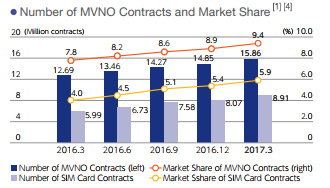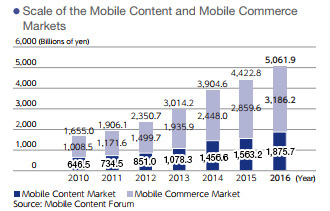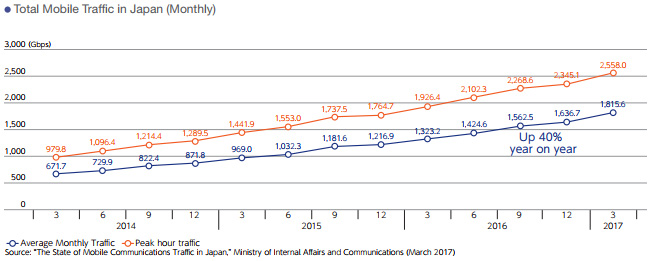- KDDI HOME
 Corporate Information
Corporate Information  Investor Relations
Investor Relations  IR Documents
IR Documents  Integrated Report
Integrated Report  Selected Pages of Integrated Report (2017)
Selected Pages of Integrated Report (2017)  The Japanese Market and KDDI
The Japanese Market and KDDI
The Japanese Market and KDDI
Mobile
As of March 31, 2017, cumulative mobile communications subscriptions in Japan totaled 162.73 million [1], up 4.0% year on year.
The mobile market continues to grow, driven by the spread of smartphones and further advances in the trend of single users owning multiple devices.
In addition, there has been significant growth in the number of service contracts for MVNOs [2], who procure networks from MNOs [3] to provide mobile services, up 6.8% from a year earlier to 15.86 million [1]. MVNO's share of the mobile telecommunications market has grown to 9.4% (5.9% if limited to SIM card contracts) [1] [4], and is expected to expand further going forward.
Further, in the IoT field for connecting a wide variety of things with the Internet, low power wide area (LPWA) specifications have been established to enable wide-area communications with low power consumption, and the telecommunications environment required for the age of IoT is gradually being established. Examples of the use of IoT by enterprises and local governments are increasing, and the mobile market is expected to expand further.
Note that the scale of the overall market created by the advance of IoT is predicted to expand from ¥520 billion in 2015 to ¥3.2 trillion in 2022 [5], and will likely take the lead in mobile market expansion going forward.


Fixed-Line Broadband
The nationwide FTTH household coverage ratio is more than 90% [6] and "homes passed [7]" is more than 70% [8], indicating that high-speed broadband environments are essentially in place nationwide.
As of March 31, 2017, fixed-line broadband service subscriptions numbered 38.69 million [1], up 2.3% from the previous fiscal year-end.
Although fixed-line broadband service penetration has reached around 70%, the market continues to expand gradually, driven by sales of discount bundled mobile and fixed-line services and the opening of new markets by new operators using the wholesaling fiber access service of NTT East and NTT West.

Non-Telecommunications Fields
As the domestic telecommunications business begins to shift toward a stage of stable growth, mobile telecommunications companies are working to secure new sources of revenue, utilizing their domestic telecommunications customer bases to more actively engage in a variety of initiatives aimed at generating revenue in nontelecommunications fields.
Also, carrier billing is a common means of paying for online mobile content services, and telecommunications companies are offering their own credit cards as a method of paying for offline services, creating a system for capturing both online and offline revenue.

Growth in Mobile Traffic
Due to the proliferation of smartphones and tablets, along with the increased performance of devices and advances in telecommunications technology, mobile traffic in Japan continues to grow, with average monthly traffic recently rising at about 40% year on year.
In particular, average traffic during the peak hours for mobile customers is up by around 40% per year. This situation poses a dilemma for mobile telecommunications companies, which are working to efficiently absorb this increase in mobile traffic and maintain stable network operations.

- Recommended Contents
-




